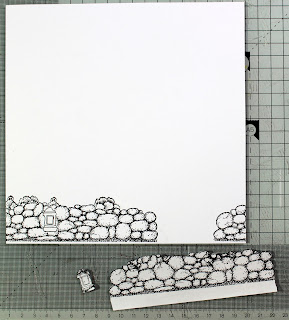Materials:
- Stamps: Landscape edges (wall and background skyline), Village Life (trees), Townhouses (trees & bushes), English Cottages (cottage, trees & bushes, post box)
- 8 X 8 inch card blank and stamping card (smooth white)
- Scrap copy paper (needs to be thin) and temporary glue adhesive (such as zig 2 way glue) or masking tissue
- Watercolour pens and inks (yellow, orange, brown, turquoise, bright green, olive green, red, pink, grey and black)
- Fine tipped water resistant pen (black and opaque white)
- Alcohol marker (black)
- Versafine (Onyx Black)
- Pebeo Drawing Gum (masking fluid)
Planning a rough layout.
The first thing that I do with a set of scene building
stamps is to stamp all the elements onto scrap copy paper and roughly cut them
out. I then use these to plan a scene, laying them out onto my project to
decide on placement. Individual elements that may be needed to create masks
(e.g. buildings, trees, bushes etc.) I cut around carefully. Any elements that
are silhouette stamps (e.g. solid black trees, branches and foliage) don’t need
to be masked so I just cut around roughly. I keep all these cut out elements to
use again for future projects.
Stamp the post box and cover with the mask before stamping
the wall. Using masking you work progressively from foreground to background.
Masking ensures that element sits in front of the one behind. Don’t worry too
much if you get a few gaps in the image around the masked elements, these are
easily corrected with a fine tipped pen.
I put a couple of dots of zig glue onto the back of my
masking pieces. It goes on blue and dries clear, and is then a tacky temporary
adhesive for holding elements in place while stamping. If you are using masking
tissue this already has a tacky backing.
Next stamp foreground trees and bushes. The foreground bush
on the left was masked before stamping the ones behind. Cover the trees with
masks.
Continue stamping and masking trees and bushes as you work
backwards through the scene.
Continue stamping and masking as you work backwards through
the scene.
Continue building the scene using masks as needed. Now can
you see where I went wrong? I forgot to mask the bushes on the right hand side
of the cottage! You can see the base of the house through the bushes. Eeek! I
decided to leave it and try and cover up the mistake with the colouring.
Stamp the clouds along the top and the birds into the sky. Mask the foreground tree and stamp the
silhouette tree on the right.
Use the fine tipped pen to draw in elements and extend the
background. Try to ‘go with the flow’ and just quickly draw. Rather than solid
lines try and be a bit sketchy with light touches, dots & dashes. To give
the illusion of perspective draw the path wider as it gets nearer the front of
the scene. Draw a letterbox and scribble text onto the post box.
Next cover the cottage and trees using the Drawing Gum. This
masking fluid is brilliant. I had always been used to the older stinky rubbery
style masking fluid that ruins your brushes. This fluid is fabulous, it paints
on easily and washes out instantly with water (treat it as you would an acrylic
paint and wash brushes immediately – it will ruin your brush if you let it dry
on).
It is not essential to mask before colouring but this makes
it much easier to slap colour across the background and leave the elements
protected.
Apply ink colours (or watercolour washes) across the
background. Work freely working ‘wet in wet’. I used intense coloured inks to
create a vibrant scene.
When the background is fully dry rub away the masking fluid.
Now colour the rest of the scene. I used watercolour pens
and a damp brush, picking up colour scribbled onto my palette.
Use the fine tipped pen to draw in a few extra details,
adding grasses and texture to the path. To keep perspective draw them slightly
larger towards the front and reducing in size as you go back. Use the opaque
white pen to add a few highlights.
Finally edge the scene with black marker to frame and mount
onto the card front.












No comments:
Post a Comment